Video lecture for this page
This material (including images) is copyrighted!.
See my copyright notice for fair use
practices. Select the photographs to display the original source in
another window.
 The astronomer Walter Baade (lived 1893--1960)
working at Mount Wilson Observatory outside of Los
Angeles was forbidden to work in the United States' military research during
World War II because of his German birth. Being a good astronomer, he took
advantage of the dark skies from the frequent blackouts of Los Angeles during
the war. He also had plenty of time at the telescope because the other
astronomers were engaged in the war effort. In 1944 he discovered
that the stars in our Galaxy can be divided into two basic groups:
Population I and Population II.
The astronomer Walter Baade (lived 1893--1960)
working at Mount Wilson Observatory outside of Los
Angeles was forbidden to work in the United States' military research during
World War II because of his German birth. Being a good astronomer, he took
advantage of the dark skies from the frequent blackouts of Los Angeles during
the war. He also had plenty of time at the telescope because the other
astronomers were engaged in the war effort. In 1944 he discovered
that the stars in our Galaxy can be divided into two basic groups:
Population I and Population II.
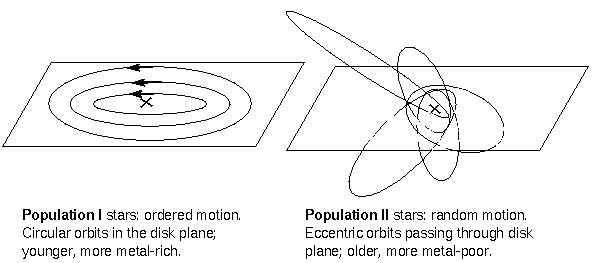
The Population I stars are in the disk component of the Galaxy.
They have a wide range of ages, from 0 to 10 billion years old. The youngest
ones are in the spiral arms. Population I star orbits
are orderly: roughly circular orbits close to the mid-plane of the galactic
disk. Young star clusters made of Population I stars are called open
clusters because the stars are loosely bound together, in contrast to the
old, concentrated globular clusters.

Population I stars have a greater abundance of elements heavier
than helium than the Population II stars. Elements heavier than helium are
often called metals in astronomy even though many of them are not the
shiny conductors called metals in popular usage. The Population I are said to
be ``metal-rich'' in comparison to the Population II stars.
There is a continuum of the metal abundance and orbit shapes. The oldest
Population I stars have 0.1 times the metal abundance of the Sun and have
slightly elliptical orbits that can take them up to 3000 light years from the
disk plane. The middle-aged stars like the Sun have metal abundances of
0.5 to 1 times solar abundance and can be found at heights up to 1100 light
years from the
disk plane. The young stars have metal abundances of 1 to 2 times the Sun's
abundance and stay within 650 light years of the disk plane. Stars less than
100 million years old are found in the spiral arms within 400 light years of the
disk plane. They have circular orbits and metal abundances of 1 to 2.5 times
solar abundance.

The Population II stars inhabit the spheroidal component (the
stellar halo and bulge). They are old: ages range from 10 to 13 billion years
old, so they have masses less than or equal to 0.8 solar masses. Their
orbits are much more randomly oriented than the Population I orbits and are
highly elliptical.
The combination of all of the elliptical orbits randomly aligned produces the
spherical distribution seen. As a unit the spheroidal component has little
overall rotation. Globular clusters are made of
Population II stars. Because they swarm around the center like bees around a hive,
the globular clusters were used to locate the center of the Galaxy as described above.
The halo
stars are metal-poor (0.001 to 0.03 times solar abundance), but the abundance
increases inward toward the center. The bulge stars have metal abundances of
1 to 3 times that of the Sun. Early in the history of the Galaxy, there was
probably a lot of star formation and death in the bulge component, so the
metal content rose quickly. The star formation rate in the disk has been
more steady, so it is slowly catching up to the bulge's metal abundance. Star
formation now occurs in just the disk. Eventually, the new disk stars will
be born with greater metal abundance than the metal-richest bulge stars.
The center of the Galaxy is in the direction of the constellation Sagittarius
about 27,000 light years from our solar system.
A strong radio source, called Sagittarius A, is seen at the center. The
radio emission is non-thermal (synchrotron) radiation from rapidly moving
charged particles spiraling around a strong magnetic field. X-rays are also
seen coming from an object less than 3 light years across.
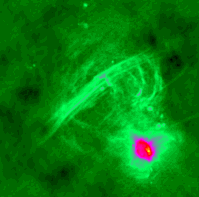
The plane of galactic disk runs from upper left to lower right. The parallel filaments are
perpendicular to galactic plane. The image is about 190 light years across.
Stellar
velocities found from the doppler shifts of the spectral lines in the stars'
spectra near the center indicate the presence of a large, compact mass at the
center with almost 4 million solar masses. It is probably a massive black
hole
formed by mergers of stars and stellar remnants. As you look closer to a
supermassive black hole, you should see the stars nearer the black hole moving
faster than the ones farther out. Stars nearer the supermassive black hole
move fast enough to balance the stronger gravity closer to the black hole.
High-resolution infrared measurements of the orbits of the stars
at the center show that a very compact mass---a
supermassive
black hole---with about 4.5 million solar masses lies at the center (if use our distance to the center as 8.3 kpc). The picture
below (courtesy of
Andrea
Ghez and
the UCLA Galactic Center Group) shows the orbits of the stars around the
black
hole from the years 1995
to
2018.
At
a distance
of 8.3 kpc for the Sun, the 0.2 arc second scale bar in the figure corresponds
to about 0.027 light years or 1680 AU. She has also released a movie
of the orbits through late 2016. The object is too compact to be a dense cluster of stars---the Chandra
X-ray Observatory's observations of X-ray bursts from the object place an upper
limit of the diameter of the object of the size of the Earth's orbit. An expanding
ring is also seen about 9000 light
years from the center. Other galaxy cores have supermassive compact objects (the
Andromeda Galaxy, M32, Sombrero Galaxy, M87, and many others). Andrea Ghez gave a talk about her research of the supermassive black hole at Keck Week in March 2013 that is now available for viewing. She discusses the early work with speckle imaging, the breakthroughs possible with adaptive optics, and the future work her research group hopes to do: link to Ghez's talk.
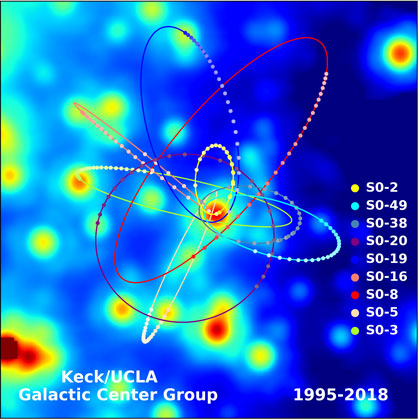
Just because there is a large black hole at the center, does not mean that
the stars in the Galaxy are all orbiting around it like the planets orbit
the Sun. Even if the supermassive black hole was not there, the stars would
still orbit pretty much as they do now because of their mutual gravity. If you
compare the enclosed mass inside the Sun's orbit (see the
mass figure above)
with the 4.5 million solar masses of the black hole, you will see
that the central black hole's mass is insignificant compared to the entire Galaxy.
Following on their realease of an image the supermassive black hole in the elliptical galaxy M87 in 2019, the Event Horizon Telescope team released their image of the Sagittarius A* supermassive black hole in 2022.
The Event Horizon Telescope used observations done in 2017 from eight radio telescopes in six locations: Hawaii, Arizona, Mexico, Spain, Chile, and the South Pole to create the image (see the figure below).
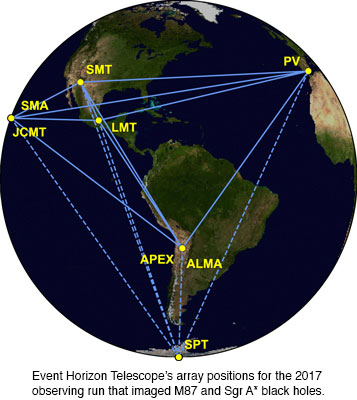
Since then, additional radio telescopes have been added to the array. The dark hole in the ring of light (the "lensed photon ring") in the image is similar to a shadow, caused by the gravitational bending and capture of light by the event horizon around the black hole. The shadow of the black hole is the closest we can come to an image of the black hole itself. The event horizon is about 2.5 times smaller than the shadow it casts. Because the event horizon of Sgr A* is about a thousand times smaller in diameter than M87's black hole, there are faster changes in the light from the swirling gas in the accretion disk around Sgr A*---gas takes 30 minutes or less to orbit Sgr A* but it takes days to weeks to orbit the M87 black hole. All that turbulence made discerning the shadow signature much harder to do. The image below is an average of the many images produced by the EHT. Select the image to bring up an enlarged version.
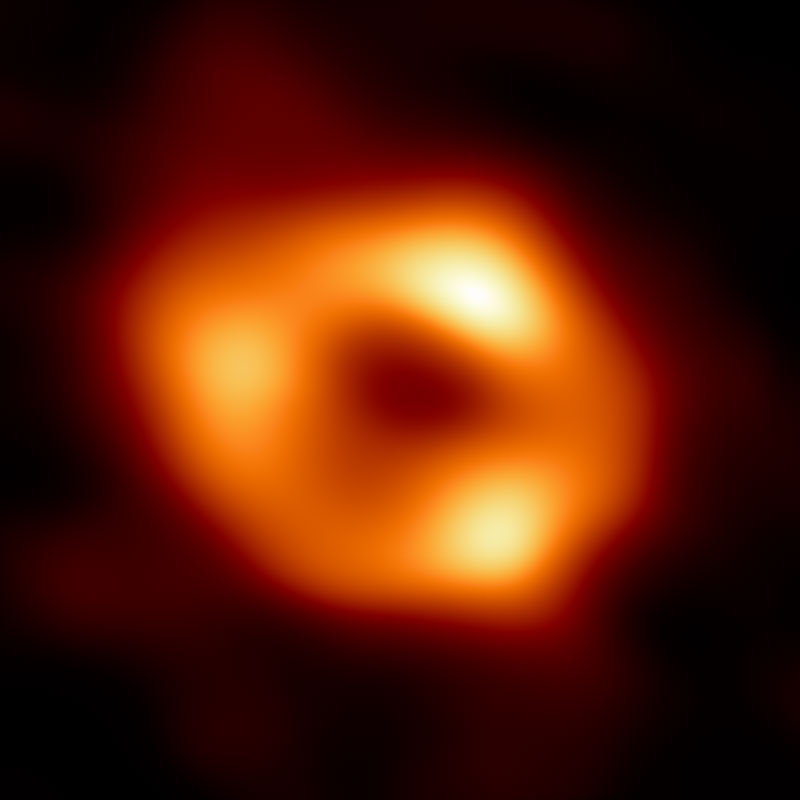
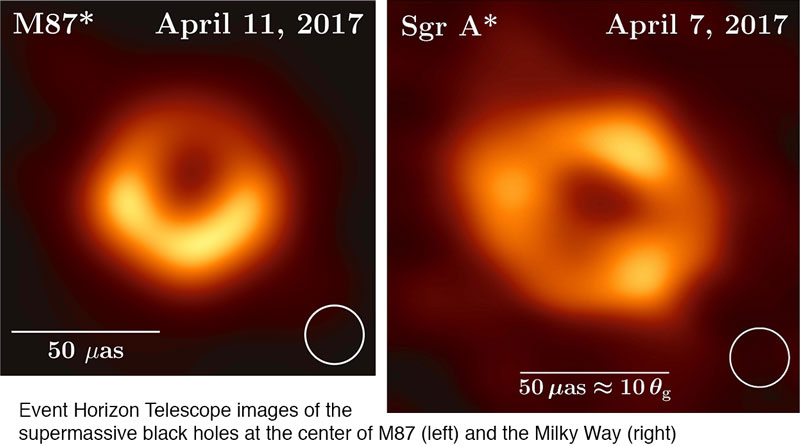
Comparison of M87's central supermassive black hole (left) with the Milky Way's central supermassive black hole (right). They have approximately the same angular size as seen from Earth because M87's black hole is about 1440 times more massive and about 2000 times farther away than Sgr A*.
 Go back to previous section --
Go back to previous section --
 Go to next section
Go to next section
last updated:
June 27, 2022
Is this page a copy of Strobel's
Astronomy Notes?
Author of original content:
Nick Strobel
 The astronomer Walter Baade (lived 1893--1960)
working at Mount Wilson Observatory outside of Los
Angeles was forbidden to work in the United States' military research during
World War II because of his German birth. Being a good astronomer, he took
advantage of the dark skies from the frequent blackouts of Los Angeles during
the war. He also had plenty of time at the telescope because the other
astronomers were engaged in the war effort. In 1944 he discovered
that the stars in our Galaxy can be divided into two basic groups:
Population I and Population II.
The astronomer Walter Baade (lived 1893--1960)
working at Mount Wilson Observatory outside of Los
Angeles was forbidden to work in the United States' military research during
World War II because of his German birth. Being a good astronomer, he took
advantage of the dark skies from the frequent blackouts of Los Angeles during
the war. He also had plenty of time at the telescope because the other
astronomers were engaged in the war effort. In 1944 he discovered
that the stars in our Galaxy can be divided into two basic groups:
Population I and Population II.







